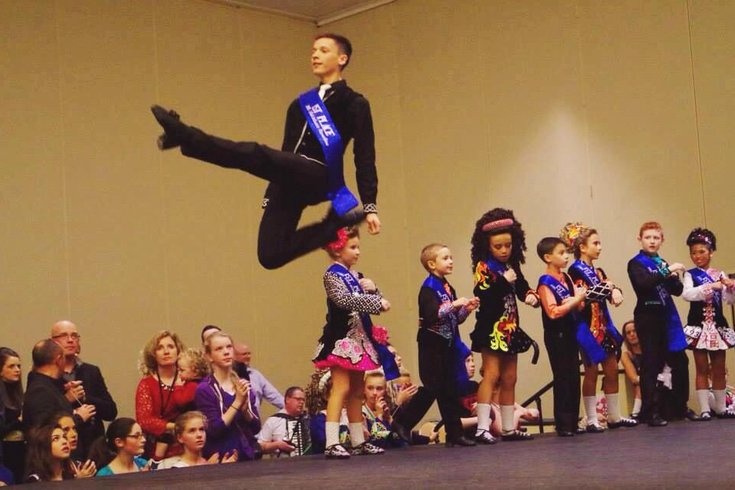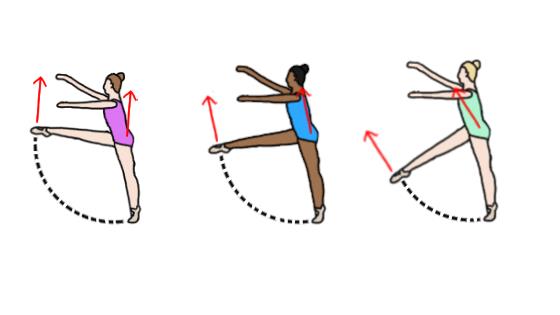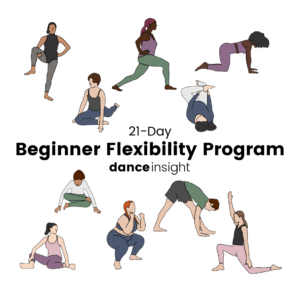How to Improve Your Leaps with Simple Physics
I’ve been told to jump higher for what seems like my entire dancing career. I actually used to have nightmares about being in dance class with my teachers yelling at me to jump higher, while in my dream state I couldn’t even get myself off the ground. It’s a weakness that has plagued me for years, this inability to jump high. I usually chalked it up to being the “flexible but not strong” type, and told myself I just needed to do more strength training.
But something clued me in that it wasn’t all about the quads and hamstrings: Irish Step Dance.
Irish Step dancers leap high without any plié

Irish Step’s softshoe dances are a constant string of small jumps, interspersed with travelling movements and big leaps. The catch: never once do your heels touch the ground or do you do any kind of plié. No plié, and yet somehow Irish Step Dancers are the highest jumpers of us all. Try to jump from relevé and you’ll instantly know that there must be more to the picture.
Watch the video below if you don’t believe me. As they slow down each jump, you can see that the dancers are not plié-ing before takeoff, and yet somehow they shoot into the air like rockets. How, I ask you, how?
Don’t worry, it’s not magic. There’s actually a simple explanation that only involves a little bit of physics!
Centripetal Force
Okay, I know you’re thinking “ugh, science,” but trust me, it’s easy to understand and will change the way you leap!
Imagine someone holding a string with a weight at the end. She swings the weight around and it moves in a circle. What happens when she lets go?

When she lets go of the string, the object will not continue to fly in a circle. It will go in a straight line from whatever position it had when she let go. (If you don’t believe me, try it at home!) That’s because the string held by her hand exerted a centripetal force on the object. Centripetal force pulls inward on the object, keeping it from flying away. (This force is counteracted by centrifugal force. You can read more about centripetal and centrifugal force here.) She releases the string, no more centripetal force, the weight flies off in whatever direction.
Okay, so that’s nice for blocks on strings, but how does that apply to dance leaps? This is where it gets cool.
Your leg as the weight on the string
Think of what happens to your leg when you do a grand battement. It’s a similar motion to the weight on the string. Does your leg have centripetal force? Sure, or else your leg would fly off every time you did a kick. But you can use the concept of flying-off-in-a-direction to help you get height on your leaps.
Think of it this way: the moment your back foot leaves the floor is the moment you let go of the weight on the string. At that moment, you’re midair, (in freefall, actually) and your hips will fly up with the momentum of your leg. But your hips are going to follow the laws of physics, so whatever position your working leg has when you leave the floor, that’s the direction you’re going to travel.

The girl on the far right might have a lot of power in her battement, and she might push off the floor with all her might, but she won’t go as high as the other two because her hips are going to go more forward than up. The force that she puts into her standing leg is only going to send her more forward.
If you’re thinking, “Well, can’t she just push straight up?” It actually doesn’t work like that. Remember, once you leave the ground, you’re in freefall. She can push as straight up as she wants, but as soon as she loses contact with the floor, she’s going to go in the direction of the force that’s still acting on her body: the momentum of her working leg.
Go back and watch that Irish Step video again. Notice that when their bottom foot leaves the floor, their working leg is 90 degrees or higher. That’s because a 90 degree battement will send you straight up in the air.
Try it yourself
You can test this at home, right now. Stand somewhere with a bit of space around you. Then, without taking any prep steps, swing a leg forward and jump. If you kick less than 90 degrees, you will feel yourself move forward. Kick exactly 90 degrees, and you should stay in place. If you kick more than 90 degrees, you’ll actually move backwards. (That’s actually how you get “hang time,” but that’s another discussion.) Get up off the couch and try it!
See? Leaping is just as much about getting the right momentum as it is about having powerful legs. It’s not even that much about plié. (But please still plié in all your jumps! Save your knees!) All of that said, here are the ingredients of a good leap:
- Forward momentum (your chassé or running steps)
- A 90 degree swing of the front leg
- A strong push off the floor from the back leg
- Beautiful technique (pointed toes, straight knees, all that stuff)
- A nice deep plié to finish (please!)
Did this work for you? What are your tips for good leaps? Let me know in the comments!
Related Post: Why Saut de Chats are Easier than Grande Jetés
Photo by Kelsea Hower Photography







